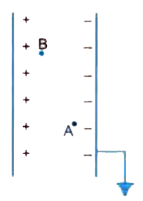An electron is emitted with negligible speed from the nagative plate of a parallel plate capacitor charged ot a potential difference V. The separtion between the plates is d and a magnetic field B exists in the space as shown in . Show that the electron will fail to strike the upper plate if ltdgt (2meVeB20)12.
 Solution in Tamil
Solution in Tamil
The force experienced first is due to the electric field due to the capacitor
SinceF.d=eV⇒q=Fm=evmed
[where e=char≥ofe≤ctronme=massofe≤ctron]
v2=u2+2 as
⇒v2=2×(eVme×d
orv=√eVme
Force due to magnetic field product
V=eB0dme
Now the electron will field strike upper plate only when V is greater then the v
Then eB0dme>√2meVeB20
Topper's Solved these Questions
Similar Questions
If a charged particle at rest experiences no electromagnetic force, then electric field in that region
View SolutionFind the range of frequency of light that is visible to an average human being (400nm<λ<700nm)
View SolutionUsing the formulae ((→F)=(→qv)×(→B)andB=(μ0)i2πr,find the SI units of the magnetic field B and the permeability constant
View SolutionAn electron enters the region between the plates of a parallel plate capacitor at an angle theta to the plates. The plate width is l , the plate separation is d . The electron follows the path shown just missing the upper plate. Neglect gravity. Then,
View SolutionAn electron having charge e and mass m starts from the lower plate of two metallic plates separated by a distance d . If the potential difference between the plates is V , the time taken by the electron to reach the upper plate is given by .
View SolutionIn a parallel plate capacitor, the distance between the plates is d and potential difference across the plate is V . Energy stored per unit volume between the plates of capacitor is
View SolutionA parallel plate air capacitor has capacity C distance of separation between plates is d and potential difference V is applied between the plates force of attraction between the plates of the parallel plate air capacitor is
View SolutionThe force between the plates of a parallel plate capacitor of capacitance C and distance of separation of the plates d with a potential difference V between the plates, is.
View SolutionElectrons are observed to be ejected in various directions with negligible speed from the negative plate of a parallel plate capacitor when the plate is illuminated by a certain wavelength. The plates are separated by a distance d and a potential difference V is maintained between them. Show that none of these electrons will reach the positive plate if a magnetic field is applied at right angles to the electric field and that the magnetic induction has a value B>(2mVed2)12 where m and e are the electron mass and charge respectively.
View SolutionA parallel plate capacitor having plate area A and separation between the plates d is charged to potential V .The energy stored in capacitor is ....???
View SolutionIn a parallel plate capacitor the potential difference of 100 V is manitianed between the plates. If distance between the plates be 5mm, what will be the electric field at points A and B ?

View SolutionAn electron enters the region between the plates of a parallel plate capacitor at an angle θ to the plates. The plate width is l, the plate separation is d. The electron follows the path shown just missing the upper plate. Neglect gravity. Then,

View SolutionA parallel plate air capacitor has capcity C distance of separtion between plates is d and potential difference V is applied between the plates force of attraction between the plates of the parallel plate air capacitor is
View SolutionIn a parallel plate capacitor, the distance between the plates is d and potential difference across the plate is V. Energy stored per unit volume between the plates of capacitor is
View SolutionAn electron having charge e and mass m starts from the lower plate of two metallic plates separated by a distance d. If the potential difference between the plates is V, the time taken by the electron to reach the upper plate is given by
 .
.
View SolutionA parallel plate capacitor is charged to a potential difference of 4 V. If the distance between the plates is 40 mm, calculate the electric field intensity between the plates.
View Solution

